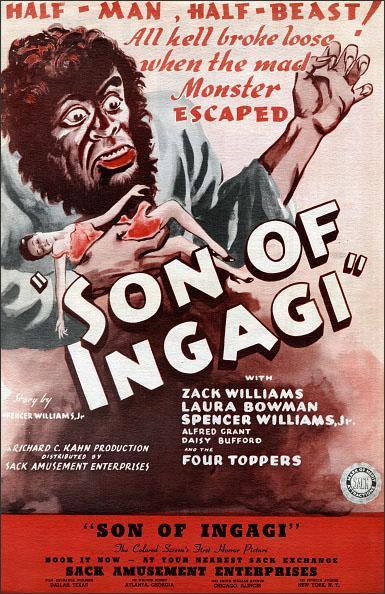 An ersatz 1940 sequel to the infamous 1930 exploitation atrocity INGAGI, Son of Ingagi is of note because it was allegedly the first all-African American horror film (if you don’t count the previous year’s DEVIL’S DAUGHTER), and also because of its unprecedented-for-1940 portrayal of a brilliant woman scientist.
An ersatz 1940 sequel to the infamous 1930 exploitation atrocity INGAGI, Son of Ingagi is of note because it was allegedly the first all-African American horror film (if you don’t count the previous year’s DEVIL’S DAUGHTER), and also because of its unprecedented-for-1940 portrayal of a brilliant woman scientist.
That woman is the elderly Dr. Helen Jackson, who’s working on a serum she promises will be the “Greatest discovery in medicine since Louis Pasteur.” As the film opens she pays a visit to the home of the just-married Robert and Eleanor Lindsay, and reveals that she knew Eleanor’s now-deceased parents on the day of their marriage (Helen admittedly had a thing for Eleanor’s father), immediately following which Helen embarked on a fateful trip to Africa.
But then the old woman drops dead under suspicious circumstances. We learn that she brought back some souvenirs from the “dark continent,” including several gold bars and a half man-half ape creature named N’Gina that provides continuity with INGAGI (despite the frequent claims made by critics that it and SON OF INGAGI have no direct relation). It’s N’Gina, under the influence of the aforementioned serum, that killed Helen, and the critter comes to threaten her acquaintances, among them Eleanor and Robert.
This is very much a “Race Film” of a type that proliferated in the 1920s, 30s and 40s, i.e. low budget films made largely by white people that were geared toward African American audiences (not unlike the Blaxploitation cycle of the 1970s), and played exclusively in segregated theaters. SON OF INGAGI is, incidentally, tied in with the other Race Films of the era by a gospel sing-along that occurs early on in the film.
The screenwriter was Spencer Williams, adapting his own story “House of Horror” (and appearing in a small acting role). Williams, best known as Andy of THE AMOS ‘N’ ANDY SHOW, became a prolific director of Race Films in the years following the release of SON OF INGAGI, with credits that include THE BLOOD OF JESUS (1941), GO DOWN, DEATH! (1945), and THE GIRL IN ROOM 20 (1946).
Regarding the director of SON OF INGAGI, Richard C. Kahn was a white man who made several Race Films in his day, among them the all-black westerns TWO-GUN MAN FROM HARLEM (1938) and HARLEM RIDES THE RANGE (1939). SON OF INGAGI is the only horror film he directed, and it’s pulled off with a surprising amount of flair.
The interior sets admittedly aren’t too invigorating (although they are quite redolent of the era), but Kahn’s technical proficiency nearly makes up for that. Particularly effective is the use of silence in the later scenes, including N’Gina’s climactic stalking and abduction of Eleanor (even if the scene’s conception is a dumb old-timey cliché). Equally invigorating is the device of a rotating wall painting, utilized quite effectively to announce the title character’s frequent arrivals through a hidden door.
None of this, however, can hope to compensate for the appearance of N’Gina. This hairy personage, incarnated by actor Zack Williams, never seems too threatening, much less scary. Perhaps it did back in 1940, but these days N’Gina looks remarkably like the critter seen by William Shatner in the classic “Nightmare at 20,000 Feet” 1963 TWILIGHT ZONE episode. If you’re not familiar with that episode, be advised that, simply, the critter therein looks plenty stupid, as does the one on display here.
Vital Statistics
SON OF INGAGI
Hollywood Pictures Corporation
Director: Richard C. Kahn
Producers: Richard C. Kahn, Alfred N. Sack
Screenplay: Spencer Williams
(Based on a story by Spencer Williams)
Cinematography: Roland Price, Herman Schopp
Editing: Dan Milner
Cast: Zack Williams, Laura Bowman, Alfred Grant, Daisy Bufford, Arthur Ray, Spencer Williams, Earl J. Morris, Jesse Graves, The Toppers
